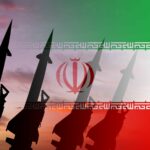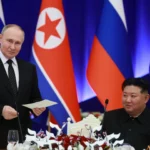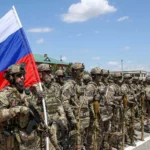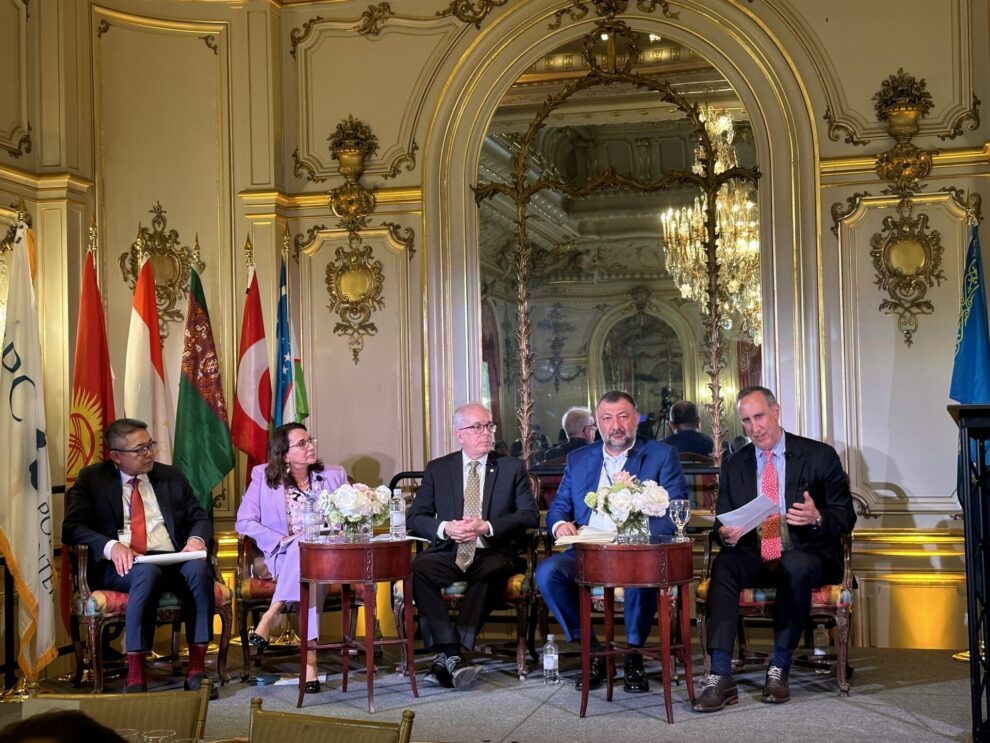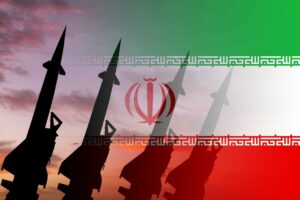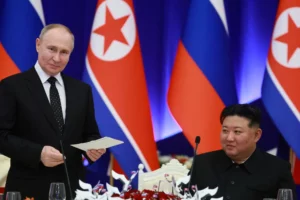For thousands of years, the famous Silk Road served as a bridge between the great ancient civilizations of the eastern and the western worlds. Today, a new Silk Road, the “Middle Corridor”, holds significant promise as a means of once more connecting nations through a multimodal route that combines roads, railways, and sea transportation. “How to Maximize the Middle Corridor” was the title and focus of a recent high-level forum organized by the Caspian Policy Center in Washington, DC at the end of May. The 8th Annual Trans-Caspian Forum gathered distinguished speakers from government agencies, diplomatic missions, international organizations and businesses to share their insights on seizing the opportunities presented by the Middle Corridor and minimizing the barriers to its success.
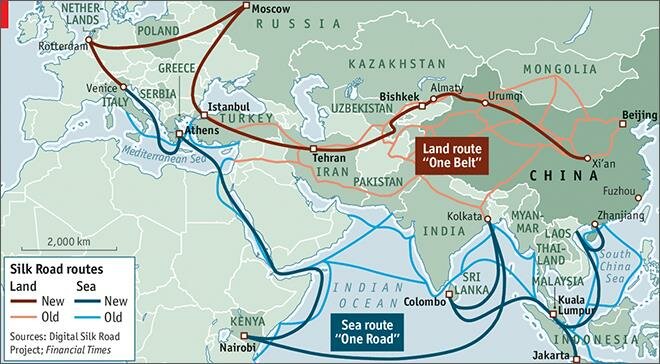
To understand the Middle Corridor, it is important to look at both its purpose and history. This Trans-Caspian International Transport Route connects east and west through Kazakhstan and the Caspian Sea. It is designed to move goods across continents: commodities enter the Caucasus through the port of Baku, Azerbaijan, and continue to Georgia. Two alternative routes can be taken from Georgia to reach Europe: a land-based route via Turkey or a maritime route via the Black Sea.
The initial idea of the Middle Corridor as a means of connecting Central Asia, the Caspian Sea region, and China to Europe “was born” in the early 2000s. It would be years, however, before the route became fully functional. In 2014, the launch of the Trans-Kazakhstan railway was a major step towards its completion. In 2017, the Baku-Tbilisi-Kars railway becoming operational provided another important piece to the system. The proper functioning of the Middle Corridor, however, truly commenced in 2020 when the first train reached China from Turkey.
Usage of the Middle Corridor and the volume of goods transported via the Trans-Caspian route have gone up significantly since 2020. A huge catalyst for these increases has been the conflict between Russia and Ukraine and the resulting sanctions against Russia. A desire to not be associated with Russia has made some businesses rethink their transportation priorities and pushed them towards selecting a route that stays out of Russian territory. According to Efgan Nifti, President of the Caspian Policy Center, who emphasized the growing geopolitical importance of the Caspian region, “the Middle Corridor has a potential to become a viable alternative to standard routes involving Russia and Belarus by shortening the…[transportation time]…by 15 days.” The Middle Corridor with over 4250 kilometers of rail lines and 500 kilometers of seaway, is one of the most sustainable links between Asia and Europe due to the favorable, sanction free environment it offers for businesses. This is not something found on the longer Northern Corridor, the route which runs from China through Kazakhstan, Russia and Belarus.
Arun Venkataraman, Assistant Secretary of Commerce for Global Markets who was a keynote speaker at the forum, underlined the strategic and economic importance of the Caspian region and the tremendous opportunities of the Middle Corridor for trade and economic development. According to his remarks, over the last two years, US trade with countries from the Caspian region has reached $40bn, U.S. exports and imports in the region are nearly split 50/50 — $20bn in U.S. exports and $20bn in U.S. imports. Venkataraman stressed that the synergy around the Middle Corridor should not be connected to the physical infrastructure alone (e.g., ports, railroads, cargo terminals). He believes the expansion of the Middle Corridor should involve communication or digital infrastructure, as well as safety and security systems. That means connecting the IT systems needed to efficiently move goods and people and technology to transmit financial services, monitor delivery of utility services and other tools that will help to promote economic cooperation between the west and the Caspian countries. Venkataraman also explored the policy challenges that have arisen with the development of the Middle Corridor. These include climate change issues and the need for a stable and predictable business environment.
John Mark Pommersheim, Deputy Assistant Secretary of State for Central Asia echoed the words of Venkataraman by emphasizing the importance of having a favorable business climate and discussing the role of the private sector in the Middle Corridor. In his remarks, he touched on the importance of ERICEN, the Economic Resilience Initiative in Central Asia launched in September 2022 to catalyze economic growth across Central Asia in the wake of Russia’s war in Ukraine. The United States provided $45mn to diversify trade routes, expand investment in the region, and increase employment opportunities in Central Asia by investing in people through education and training. In addition, since 2021 the United States Agency for International Development (USAID) within its Central Asia trade program has invested more than $24mn. This investment is intended to help harmonize customs legislation, increase public private dialogue and improve connectivity between Central Asian countries.
While all the speakers at the Caspian Forum shared insights and information, it was Khazar Ibrahim, the Azerbaijani Ambassador, who had the most captivating presentation. He claimed that in order to maximize the potential of the Middle Corridor, countries participating in it need to minimize key things. They must bring down risks, costs (for the companies doing business), barriers, and obstacles. He raised the question as to how the countries involved in the Middle Corridor should achieve such minimization. He offered a simple but profound answer: that the countries should engage with each other multilaterally. For example, countries could connect through groups such as the Organization of the Turkic states that helps to smooth customs regulations between countries. He emphasized the role of trilateral cooperation, too, giving an example of the collaboration amongst Turkey, Azerbaijan, and Georgia. He also noted that the bilateral relations between the countries of the region can serve as another way to minimize obstacles. Ibrahim suggested that countries need to look beyond the role of the Middle Corridor as a potential shortest route for transporting goods from China to Europe. He remarked that the Corridor should be considered not just as a means of trading goods, but as a route for exchanging technology, culture, and ideology, creating contacts between people. The original ancient Silk Road connected different cultures, cities and people, allowing for an exchange of goods, ideas, scientific knowledge, languages, and religions. Ibrahim believes that the Middle Corridor can serve a similar role today. He raised the idea that wind can become new silk, for example. According to the ambassador, creating a Caspian-European green energy corridor could be a great way to maximize the Middle Corridor’s potential and transfer electricity to European countries. Multiplying capacities, according to his remarks, is another way to strengthen cooperation in the region. For example, Baku-Tbilisi-Kars, the railway which opens up huge transport opportunities from Tbilisi to Istanbul via Kars and Ankara, can significantly benefit from the capacity boost, and current modernization can increase its capacity five-fold, to 5mn tons annually.
Each speaker at the forum brought their own unique viewpoint on the Middle Corridor and the best usage of the rich possibilities of this route. Bakyt Amanbayev, the Ambassador of Kyrgyz Republic, stressed the importance of Central Asia to global economic development due to its wealth of mineral resources. He also highlighted the importance of the large scaled “China-Kyrgyz Republic-Uzbekistan-Pakistan” railway project, an undertaking promising to provide greater connectivity to China’s markets and open sea links for landlocked Central Asian countries. Amanbayev named it “the project of the century” for Kyrgyzstan.
Ambassador Furqat Sidiqov of Uzbekistan reminded forum participants that Uzbekistan ranks fourth in the world in processing gold reserves, seventh in gold mining, eighth in natural gas production, tenth in copper reserves and seventh in uranium reserves. With a GDP of more than $100bn and foreign trade turnover of more than $70bn in 2023, Uzbekistan is one of the key players in the Central Asian region that is ready to export six thousand types of goods to Europe, according to Sidiqov. Along with highlighting his country’s financial and trade significance, Sidiqov also made a case for legislative change. In his remarks, he mentioned the need to repeal the Jackson-Vanik amendment. This amendment, in effect for half a century, limits trade relations between the USA and “non-market” economies that restrict Jewish emigration and violate other human rights. Sidiqov described the amendment as a heritage of the past, noting it is imperative for the US government and Central Asian countries to work towards its removal.
Representing Kazakhstan at the Forum was Rauan Tleulin, the country’s Deputy Chief of Mission. He noted that, as in the case of Uzbekistan, with increasing capacity, the Middle Corridor can greatly help Kazakhstan to diversify its transportation capacity. There have been some significant steps already taken to this end, with the volume of cargo transported through the Middle Corridor doubling. Kazakhstan has also signed agreements to increase the transportation of oil through Azerbaijan. These agreements (signed between the national oil companies Kazmunaygas and SOCAR) aim to increase the transportation of oil through the Aktau-Baku-Tbilisi-Ceyhan pipeline by 2-2.2mn tons annually. The next goal for Kazakhstan, according to Tleulin, is to develop infrastructure projects, increase investment and improve the investment climate. Together with Azerbaijan, Georgia and Turkey, Kazakhstan has adopted a roadmap for the “further simultaneous elimination of bottlenecks that will potentially increase the capacity of the Middle Corridor to 10mn tons a year by 2025.” Another step that can potentially boost Kazakhstan’s participation in the Middle Corridor could come through establishing a joint venture with the Abu Dhabi port in order to develop the Caspian fleet in transporting oil to European markets. Tleulin also underlined the commitment made by the European Commission to contribute €10bn for sustainable transport development in Central Asia. According to Tleulin, Kazakhstan awaits the same “response” from US partners through the Partnership for Global Infrastructure and Investment (PGI) program and Mineral Security Partnership.
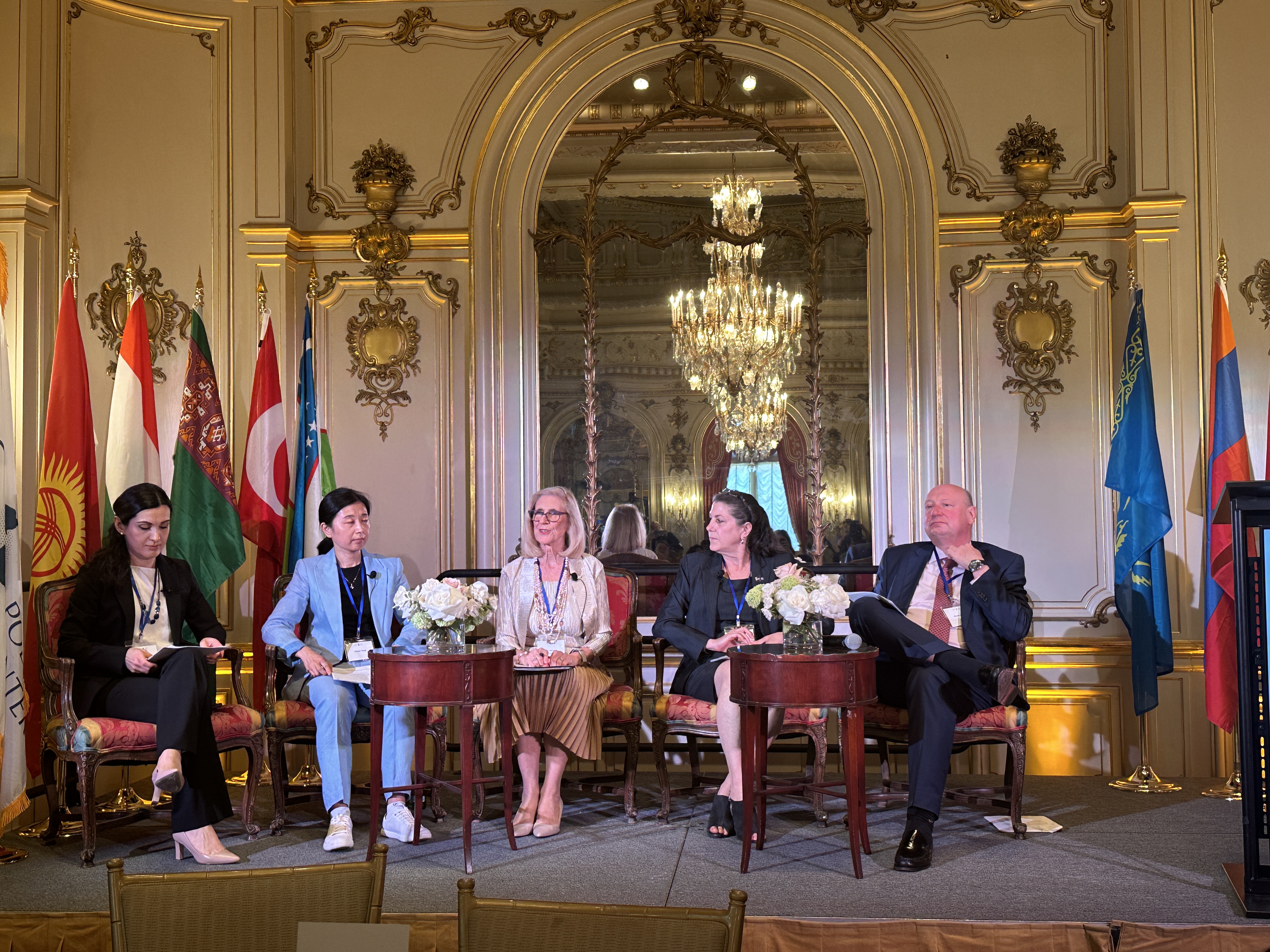
Along with individual speakers, the forum also included a panel, led by Dr Marsha McGraw Olive. Dr McGraw Olive shared insights into the work of international organizations and financial institutions on the pressing issues connected to the planning and coordination of investment related to the Middle Corridor. When discussing the Middle Corridor, Dr. McGraw Olive stated, “we aren’t talking about one country or one project, we are talking about minimum of eight countries or even 10 if we count Bulgaria and Romania as the World Bank does. It will not involve just one project, but multiple projects in hard and soft infrastructure -it is road, rail, and maritime and it is a nightmare of collective action as it is very difficult to coordinate the efforts on prioritization of the projects and tasks.”
Henrik Hololei, who worked as the Minister of the Estonian Economy in the past and played an instrumental role in Estonia’s ascension to the European Union before continuing his career at the European Commission, shared an “EU viewpoint” on the Middle Corridor as part of the panel. He reminded forum participants that in recent years, Europe and Central Asia have strengthened their cooperation with several high-level visits. As well, he noted that the first ever EU Central Asia Summit will take place later this year. He stressed that many economic and societal reforms that the Central Asian countries are currently implementing can turn the Central Asian area into a fast-developing region. Hololei observed that the European Union’s interests in Central Asia include: trade, green transition and transport connectivity in the framework of the Trans Caspian Corridor. The EU is the biggest investor in Central Asia with more than 40% of the accumulated investment in the region. In his speech, Hololei emphasized that the European Commission prefers to use the phrase “Trans Caspian Corridor” instead of the “Middle Corridor” because the Commission includes all the five countries of Central Asia as well as the countries of Caucasus and Turkey.
Ambassador Erin Mckee from the Europe and Eurasia Bureau at the USAID touched on the pivotal role of the private sector in the development of the Corridor. She posed two thought provoking questions about the Corridor, asking “Will it be bogged by corruption, inconsistent rules and policies, arbitrary rules that provide access to some but not all?” or “will the Corridor be based on transparency, rule of law, [and the] free flow of not only goods and services [but also a human-centric approach]?”. She stated that the USAID launched an almost $24.5mn flagship initiative in the South Caucasus region that will accelerate Middle Corridor development. With the help of this program, the USAID believes, $200mn in investment will be unlocked, transport efficiency will be enhanced by 30%, and transit time will be cut down by 20%. The ambassador also shared that the Asian Bureau of the USAID invested $24mn in “the trade activity” of Central Asia. Since 2021, according to McKee, the program has helped to harmonize customs and border procedures, facilitated public-private dialogues, and supported improvements in the Middle Corridor such as a modernized terminal operating system at the Caspian port Kuryk. In the Caucasus, she noted that the USAID is integrating Armenia in the existing trade routes running through the Middle Corridor. Despite such positive developments, the overall success will depend on multiple players such as public sector, private sector, and international financial institutions. One of the steps in this direction can be the agreement signed between USAID and EBRD in May this year that can potentially connect some dots in helping to build an effective Middle Corridor. The ambassador emphasized the need to move from “donor coordination” to “donor execution” and called for producing “more palpable, more meaningful and more intentional work together in real time and in an accelerated fashion.”
Winnie Wang, Lead Infrastructure Specialist and Program leader for Europe and Central Asia at the World Bank also spoke at the forum. Wang shared three key points about the Corridor. First, the Corridor is multidimensional. Because of this multidimensional nature its development is not just about trade and requires institutional development first. Second, one of the defining characteristics of the Corridor, being multimodal (using rail, air, road and sea transport) is actually a source of inefficiency. This “hurdle”, however, can be turned into an opportunity, according to Wang. The final point made by Wang was that results are visible when projects are designed to address specific bottlenecks. She also emphasized a huge role of private capital mobilization in developing the Corridor.
Speaker Tamar Satterwhite, Senior Counsel at the U.S. Department of Commerce, focused on “soft connectivity issues” that “are equally important as hard infrastructure.” Satterwhite underlined that since 2023 the Department of Commerce has had three regional events that involved the C5 countries as well as Georgia and Azerbaijan. Since 2023, the CLDP has developed a joint action plan and launched a coordination platform on soft connectivity measures. Satterwhite clearly stated that while everyone is trying to advance the Middle Corridor, there is a lack of coordination and information sharing between the donor organizations, among the countries in the region, and within specific ministries in particular countries.

While many speakers represented a governmental perspective, voices from the business sector were definitely also showcased in the forum. Robert Scher, Vice President of BP America, commented that the Middle Corridor is in many ways no different than any other place to do business. Admitting that doing business from an oil and gas sector perspective makes it easier to operate in the Caspian region (and that continuing business will be beneficial to BP), he noted that there are still hurdles to doing business along the Middle Corridor. One of these barriers is poor integration in the region. Another problem is weak regulatory reforms. Maintaining the consistency of that regulation is also very critical. Scher cited the improvement in human capital as a big issue, despite the prior success BP has had in the region. In addition, Scher touched on the importance of openness to investment, clarity and consistency regarding rules, the maintenance of contracts and overall peace and stability. He noted that while companies that are already operating in the region can adapt to tensions in the area and figure out ways of continuing to work there, for new companies to feel comfortable bringing investment they will need to see the region at peace and its member countries being better integrated.
Mamuka Murjikneli, the CEO of Wonderment Investment Group, a joint US-Georgian company that owns and operates a multimodal terminal at Batumi seaport transporting fertilizers from Central Asia to the western markets, also highlighted the importance of security in the region. He stressed the need for greater government support, especially in building a deeper seaport in Georgia. He drew the participants’ attention to the urgent need for better infrastructure in order to handle growing volumes of cargo.
Laura Brank, a lawyer with decades of experience in the Caspian region, spoke about legal challenges in the region. She stated that despite significant improvements, the non-transparent nature of laws and inconsistencies between the laws present a difficulty for investors who are often confused as to which laws actually apply to them. She particularly mentioned some tax laws that constantly change. Bureaucratic delays, according to Brank, are another obstacle that has been “really problematic and frustrating for investors.” She also mentioned poor infrastructure – investors producing some goods simply cannot export them from the countries in the region. Another concern, according to Brank, is compliance. She commented that incidents of corruption are unfortunately still common in the region. Contractual risks, enforcement in courts, and the quality of judgement in courts in the countries of the Caspian region are all issues that need addressing.
Eugene Seah, Chief Operating Officer at the Baku International Sea Trade Port emphasized that for doing business in the Middle Corridor, one must take into account the perspective of Central Asia and Azerbaijan, areas “bound by historical ties.” He quoted the Azerbaijani President who said that the Central Asian countries and Azerbaijan “represent a single historical, cultural and geopolitical space with increasing strategic significance.” He stated that the Russian Ukrainian conflict urged these countries to look for other ways to transport their energy resources, chemicals and metals. These products were previously supplied by Russia and Ukraine. Now these goods come from Central Asia, a region that can also supply grains. This grain supply has the potential to contribute to food security. Seah claimed that the future will require a “green terminal” as well. He stressed that “all these things came about because of Azerbaijan’s diversification strategy.” Providing a free economic zone next to the port has been a huge factor, said Seah. He concluded, that “with this in mind, we have to look at the Middle Corridor from a different perspective.” He remarked, “it is not just between Europe and China or China and Europe.” He observed that it needs to be beneficial for all the countries along the Middle Corridor. He also stressed that the success of the Northern Corridor is mainly due to the existence of the Eurasian Economic Union. And the fact that there is an institution to do all the work on “implementing all these measures, collaborating, reaching agreements, formalizing it, tracking it, institutionalizing it.” But in Central Asia, there is no such institution, he noted. He also spoke about increasing opportunities for the Central Asian countries to export oil through independent pipelines that the port Baku can offer. In addition, he touched on the topic of the uranium exports of Kazakhstan, a country which does not have enough capacity to enrich uranium itself at this moment.
Arthur Gregorian, the Armenian chief of mission, highlighted the peace-making initiative between Armenia and Azerbaijan. The attendance of representatives from both of these two nations at the event was of significance in and of itself. For the Caspian region to be a transportation hub, peace and stability are vital to its success. It was heartening to see a tangible effort to bring two sides in a conflict together in a positive forum.
If the Middle Corridor is indeed to become the “New Silk Road” then it will need new rules and regulations, new approaches and fresh thinking to surmount the challenges and embrace the opportunities offered. The recent Caspian Forum drew together some of the thinkers, governmental leaders and businesspeople who can be at the forefront of maximizing the possibilities of this vital trade route.
Source: Daryo


